初中英语八种时态归纳一览表
(完整版)初中英语八种时态总结归纳
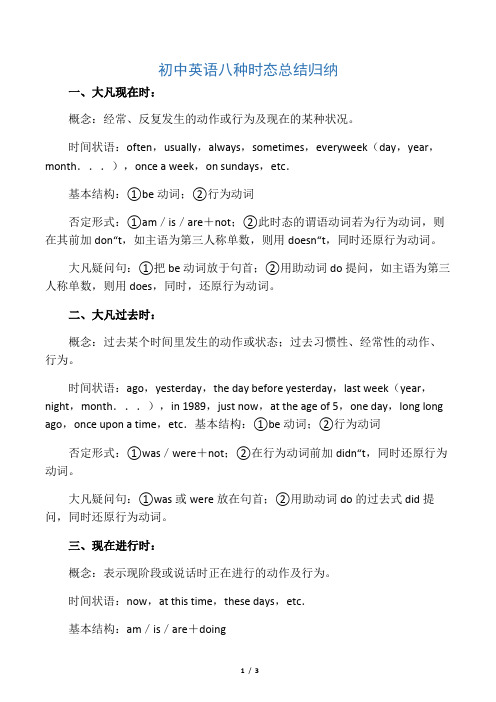
初中英语八种时态总结归纳一、大凡现在时:概念:经常、反复发生的动作或行为及现在的某种状况。
时间状语:often,usually,always,sometimes,everyweek(day,year,month...),once a week,on sundays,etc.基本结构:①be动词;②行为动词否定形式:①am/is/are+not;②此时态的谓语动词若为行为动词,则在其前加don“t,如主语为第三人称单数,则用doesn“t,同时还原行为动词。
大凡疑问句:①把be动词放于句首;②用助动词do提问,如主语为第三人称单数,则用does,同时,还原行为动词。
二、大凡过去时:概念:过去某个时间里发生的动作或状态;过去习惯性、经常性的动作、行为。
时间状语:ago,yesterday,the day before yesterday,last week(year,night,month...),in 1989,just now,at the age of 5,one day,long long ago,once upon a time,etc.基本结构:①be动词;②行为动词否定形式:①was/were+not;②在行为动词前加didn“t,同时还原行为动词。
大凡疑问句:①was或were放在句首;②用助动词do的过去式did提问,同时还原行为动词。
三、现在进行时:概念:表示现阶段或说话时正在进行的动作及行为。
时间状语:now,at this time,these days,etc.基本结构:am/is/are+doing否定形式:am/is/are+not+doing大凡疑问句:把be动词放在句首四、过去进行时:概念:表示过去某段时间或某一时刻正在发生或进行的行为或动作。
时间状语:at this time yesterday,at that time或以when引导的谓语动词是大凡过去时的时间状语等。
初中八大时态总结
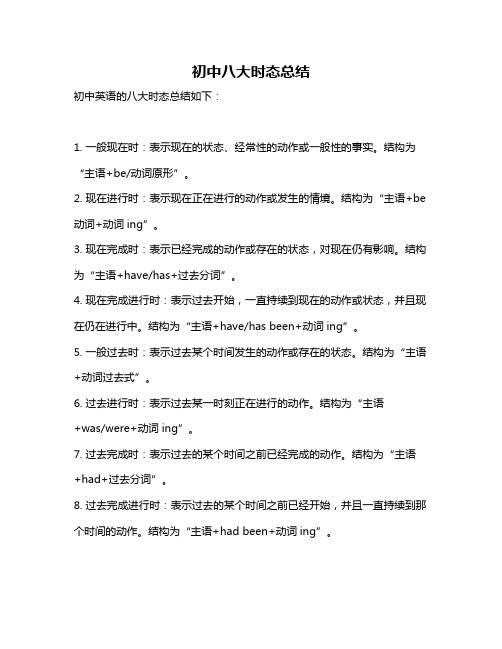
初中八大时态总结
初中英语的八大时态总结如下:
1. 一般现在时:表示现在的状态、经常性的动作或一般性的事实。
结构为“主语+be/动词原形”。
2. 现在进行时:表示现在正在进行的动作或发生的情境。
结构为“主语+be 动词+动词ing”。
3. 现在完成时:表示已经完成的动作或存在的状态,对现在仍有影响。
结构为“主语+have/has+过去分词”。
4. 现在完成进行时:表示过去开始,一直持续到现在的动作或状态,并且现在仍在进行中。
结构为“主语+have/has been+动词ing”。
5. 一般过去时:表示过去某个时间发生的动作或存在的状态。
结构为“主语+动词过去式”。
6. 过去进行时:表示过去某一时刻正在进行的动作。
结构为“主语
+was/were+动词ing”。
7. 过去完成时:表示过去的某个时间之前已经完成的动作。
结构为“主语+had+过去分词”。
8. 过去完成进行时:表示过去的某个时间之前已经开始,并且一直持续到那个时间的动作。
结构为“主语+had been+动词ing”。
以上是初中英语八大时态的总结,希望对你有所帮助。
初中英语八种时态归纳总结表格版

经常、 反复发生的 动作或行为及现 在的某种状况。
②行为动词: 肯定:主语+ do(does) + 其他 否定:主语 + don't / doesn’t + 动原 问句: Do /Does + 主语 + 动原?
答:Yes…do/does ./ No,… don’tdoesn’t.
特殊:Wh… + do /does 的疑问句?
名师推荐
精心整理
学习必备
初中英语八种时态归纳
时态 一 般 现 在 时 意义 时间状语 always, usually, often , sometimes, every week (day, year , month…), Once a week, On Sundays 结构及变化 ①be 动词: 肯定:主语+ be (am/ is /are ) + 其他 否定:主语+ am/is/are + not + 其他 问: Be (am/ is are )+ 主语 + 其他? 答:Yes …be ./ No ,…be not . 特殊:Wh… + Be 的疑问句?
现在 完成 时
recently, lately, since+ 时间点 for+ 时间段。 =(since + 时间点 ago) in the past few years,
基本结构: 肯定:主语+ have/has+ done(动词的过去分词) 否定:主语 have/has+ not+ done. (动词的过去分词) 问句:主语+have/ has + done(动词的过去分词)? 答:Yes …have /has ./ No ,…have/has not . 特殊:Wh…+ have/has 主语 + 疑问句?
初中英语八种时态一览表 (精华版)
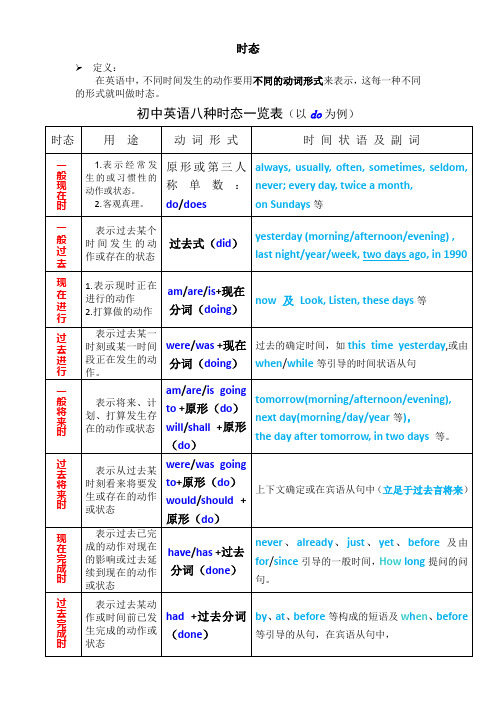
过去Байду номын сангаас行时
表示过去某一时刻或某一时间段正在发生的动作。
were/was+现在分词(doing)
过去的确定时间,如this time yesterday,或由when/while等引导的时间状语从句
一般将来时
表示将来、计划、打算发生存在的动作或状态
过去完成时
表示过去某动作或时间前已发生完成的动作或状态
had+过去分词(done)
by、at、before等构成的短语及when、before等引导的从句,在宾语从句中,
am/are/is going to+原形(do)
will/shall+原形(do)
tomorrow(morning/afternoon/evening),
next day(morning/day/year等),
the day after tomorrow, in two days等。
过去将来时
表示从过去某时刻看来将要发生或存在的动作或状态
on Sundays等
一般过去时
表示过去某个时间发生的动作或存在的状态
过去式(did)
yesterday(morning/afternoon/evening) ,
last night/year/week,two daysago, in 1990
现在进行时
1.表示现时正在进行的动作
2.打算做的动作
am/are/is+现在分词(doing)
时态
定义:
在英语中,不同时间发生的动作要用不同的动词形式来表示,这每一种不同的形式就叫做时态。
(完整版)初中英语八种时态归纳总结表格版
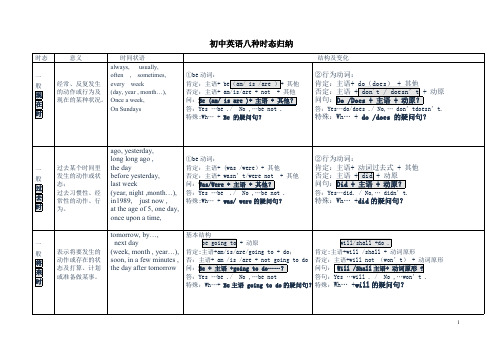
特殊:Wh… + was/ were 的疑问句?
特殊:Wh… +did 的疑问句?
时 为。
at the age of 5, one day,
once upon a time,
tomorrow, by…,
基本结构
一
next day
be going to + 动原
will/shall +do .
般 表示将要发生的 (week, month , year…), 肯定:主语+am/is/are/going to + do;
问句: Will /Shall 主语+ 动词原形 ?
或准备做某事。
答:Yes …be ./ No ,…be not
答句:Yes …will . / No ,…won’t .
时
特殊:Wh…+ Be 主语 going to do 的疑问句?特殊:Wh… +will 的疑问句?
1
The shortest way to do many things is to only one thin
②would +do . 肯定:主语+ would + 动词原形 否定:主语+ would not (wouldn’t) + 动词原形 问句:Would 主语+ 动词原形 ? 答句:Yes …would. / No ,…wouldn’t .
特殊:Wh… +would 的疑问句?
2
The shortest way to do many things is to only one thin
The next day (morning,year…), the following month (week…)
初中英语八种时态一览表 (精华版)

初中英语八种时态一览表 (精华版)作发生在现在之前,常用于叙述过去的经历和事件。
通常与具体时间状语连用,如yesterday。
last week。
two years ago 等。
例如:Yesterday。
I went to the park with my friends.现在进行时表示现在正在进行的动作或状态。
通常用于现在时态的句子中,使用现在分词形式。
例如:I am studying English now.过去进行时表示过去某一时刻正在进行的动作或状态。
通常与具体时间状语连用,如yesterday at this time。
while I was cooking dinner等。
使用过去式be动词(were/was)和动词的现在分词形式。
例如:I was watching TV when he called me.一般将来时表示将要发生的动作或状态。
通常用于表示未来的计划或打算。
使用will/shall加动词原形。
例如:I will go to the XXX.过去将来时表示过去某个时间点将要发生的动作或状态。
通常与具体时间状语连用,使用过去式be动词(were/was)和动词的原形。
例如:Yesterday at this time。
I was going to theparty with my friends.现在完成时表示过去发生的动作对现在的影响或过去延续到现在的动作或状态。
使用have/has加动词的过去分词形式。
例如:I have finished my homework。
so I can relax now.过去完成时表示过去某个时间点之前已经完成的动作或状态。
通常与具体时间状语连用,使用had加动词的过去分词形式。
例如:By the time I arrived。
he had already left.需要使用连词that来引导。
When writing an article。
初中英语语法八大时态总结完整版
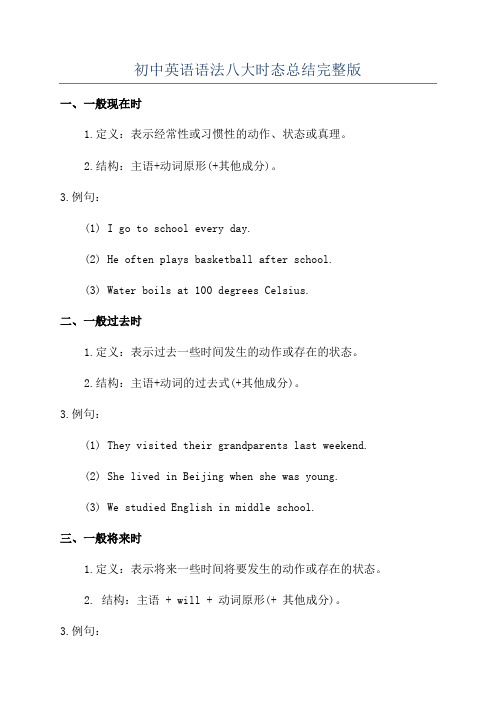
初中英语语法八大时态总结完整版一、一般现在时1.定义:表示经常性或习惯性的动作、状态或真理。
2.结构:主语+动词原形(+其他成分)。
3.例句:(1) I go to school every day.(2) He often plays basketball after school.(3) Water boils at 100 degrees Celsius.二、一般过去时1.定义:表示过去一些时间发生的动作或存在的状态。
2.结构:主语+动词的过去式(+其他成分)。
3.例句:(1) They visited their grandparents last weekend.(2) She lived in Beijing when she was young.(3) We studied English in middle school.三、一般将来时1.定义:表示将来一些时间将要发生的动作或存在的状态。
2. 结构:主语 + will + 动词原形(+ 其他成分)。
3.例句:(1) I will go to the park tomorrow.(3) We will have a party next week.四、现在进行时1.定义:表示现在正在进行的动作。
2. 结构:主语 + am/is/are + 动词-ing(+ 其他成分)。
3.例句:(1) She is reading a book right now.(2) They are playing soccer in the park.(3) We are having dinner at the moment.五、过去进行时1.定义:表示过去一些时间正在进行的动作。
2. 结构:主语 + was/were + 动词-ing(+ 其他成分)。
3.例句:(1) He was watching TV at 8 o'clock last night.(2) They were traveling in Europe during summer vacation.(3) We were studying when the phone rang.六、将来进行时1.定义:表示将来一些时间正在进行的动作。
初中英语语法八大时态总结(完整版)
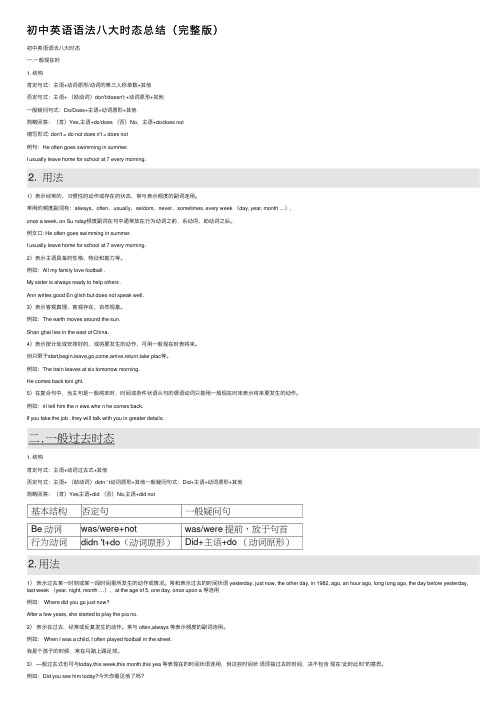
初中英语语法⼋⼤时态总结(完整版)初中英语语法⼋⼤时态⼀.⼀般现在时1. 结构肯定句式:主语+动词原形/动词的第三⼈称单数+其他否定句式:主语+ (助动词)don't/doesn't +动词原形+其他⼀般疑问句式:Do/Does+主语+动词原形+其他简略回答:(肯)Yes,主语+do/does (否)No,主语+do/does not缩写形式: don't = do not does n't = does not例句:He often goes swimming in summer.I usually leave home for school at 7 every morning.1)表⽰经常的、习惯性的动作或存在的状态,常与表⽰频度的副词连⽤。
常⽤的频度副词有:always、often、usually、seldom、never、sometimes, every week (day, year, month …),once a week, on Su nday频度副词在句中通常放在⾏为动词之前,系动词、助动词之后。
例⼥⼝: He often goes swimming in summer.I usually leave home for school at 7 every morning.2)表⽰主语具备的性格、特征和能⼒等。
例如:All my family love football .My sister is always ready to help others .Ann writes good En glish but does not speak well.3)表⽰客观真理、客观存在、⾃然现象。
例如:The earth moves around the sun.Shan ghai lies in the east of China.4)表⽰按计划或安排好的,或将要发⽣的动作,可⽤⼀般现在时表将来。
初中英语动词八种时态

1.一般过去时:主语+动词或be的过去时+名词2.一般现在时:主语+is/am/are+其它3.一般将来时:主语+am/is/are+going to +do +其它4.一般过去将来时:主语+was/were +going to +do +其它5.现在进行时:主语+be+doing+其它6.过去进行时:主语+was/were +doing +其它7.将来进行时:主语+shall/will+be+现在分词+其它8.过去将来进行时:should/would+be +现在分词9.现在完成时:主语+have/has+p.p(过去分词)+其它10.过去完成时:主语+had+p.p(过去分词)+其它11.将来完成时:主语+be going to /will/shall +have +p.p(过去分词)+其它12.过去将来完成时:should/would have done sth13.现在完成进行时:主语+have /has+been +doing +其它14.过去完成进行时:主语+had+been+doing++其它15.将来完成进行时:shall/will have been doing16.过去将来完成进行时should /would +have +been+现在分词需要重点掌握的9种时态:1、一般现在时主要用于下面几情况:1) 描述当前时间内经常出现、反复发生的动作或存在的状态。
在这种情景中,句子常带有表示频率的时间状语:always , everyday , often , once a week (month , year , etc.) , sometimes , seldom , usually等等,以表示句中的动作或状态是习惯性的、经常性的。
例如:They raise ducks as a sideline .他们以养鸭为副业。
She doesn't often write to her family, only once a month. 她不常给家里写信,仅一月一封而已。
初中英语八大时态总结
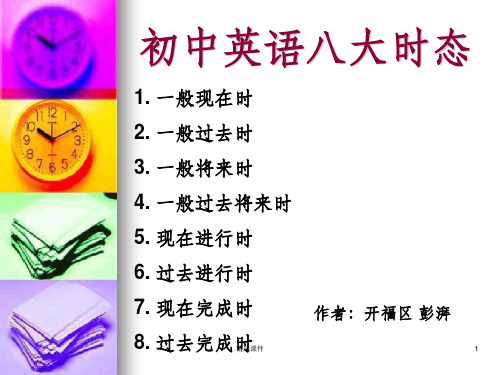
3. 一般将来时
will 加原型。
4. 一般过去将来时 would 加原型。
5. 现在进行时 6. 过去进行时 7. 现在完成时 8. 过去完成时精选课件
am/ is/ are +ing。 was/ were +ing。 have/ has + ed。 had + ed。
10
一般现在时 一般现在时,在没有be动词和助动词have,has,
一般现在时
精选课件
19
我昨天踢足球了。
一般过去时
精选课件
20
两星期前我说 过我将踢足球。
一般过去将来时
精选课件
21
我现在正 在踢足球。
现在进行时
精选课件
22
昨天的这个时候 我正在踢足球。
过去进行时
精选课件23Fra bibliotek我已经踢完足球了。
现在完成时
精选课件
24
昨天,你见到我 的时候,我早就 踢完足球了。
精选课件
8
过去完成时
含义:有两个过去时,其中一 个过去时比另一个过去时还要 过去,即一个动作发生在“过 去的过去”。 例如:昨天下午 我走进教室的时候同学们早就 坐好了、昨天当我走进电影院 的时候电影早就开始了。·
精选课件
9
初中英语八大时态
1. 一般现在时 2. 一般过去时
三单s,es其它无变化。 词尾加ed。
否: I did’t work here.
问:Did you work here?
答:Yes, I did./ No, I didn’t.
精选课件
12
一般将来时
肯: I wil work here.
初中英语八种时态大全最新版

八种时态一、一样此刻时:概念:表示现时期常常或适应发生的动作或存在的状态,或说明主语的特点。
用法:A) 表示此刻发生的动作、情形、状态和特点。
B) 常常性、适应性动作。
常与频率副词连用。
Eg.:He always helps others. (他老是帮忙他人。
)C) 客观事实和普遍真理。
Eg. The earth turns round the sun.(地球绕着太阳转)Light travels faster than sound.(光传播比声音快)D) 表示一个按规定、打算或安排要发生的动作,(仅限于某些表示“来、去、动、停、开始、终止、继续”等的动词)能够与表示以后时刻的状语搭配利用。
常见的用法是:飞机、火车、轮船、汽车等按期定点运行的交通方式。
Eg.The next train leaves at 3 o'clock this afternoon.Eg.How often does this shuttle bus run? (这班车多久一趟?)E) 在时刻状语从句中(以when, after, before, while, until, as soonas等引导)和条件状语从句中(以if,unless引导),用一样此刻时期替一样以后时,句子能够有以后时刻。
Eg.:Please ring me up as soon as you arrive in Germany.(你一到德国就给我打电话)If it rains tomorrow,we will have to stay at home.(若是明天下雨咱们就只好呆在家)时刻状语:always, usually, often, sometimes, every week (day, year, month…), once a week, on Sundays, etc.大体结构:①be动词;②行为动词否定形式:①am/is/are+not;②现在态的谓语动词假设为行为动词,那么在其前加don't,如主语为第三人称单数,那么用doesn't,同时还原行为动词。
(完整版)初中英语八种基本时态总结

初中英语基本时态总结Ⅰ、一般现在时1、概念:1)表示经常性或习惯性的动作,常与表示频度的时间状语连用。
时间状语:always, usually, often, sometimes, seldom, never, every day, twice a week, on Sunday, etc.(提问用How often)例:I leave home for school at 7 every morning.Tom gets up at 6:00 every morning.2)客观真理,客观存在,科学事实。
例:The earth moves around the sun. 地球绕太阳转动。
Shanghai lies in the east of China. 上海位于中国东部。
3)格言或警句。
例:Pride goes before a fall. 骄者必败。
注意:宾语从句中,即使主句是过去时,从句谓语是客观真理也要用一般现在时。
例:Columbus proved that the earth is round. 哥伦布证实了地球是圆的。
2、结构:表状态S+ am/is/are+ P (句中有实义动词不用be)表动作S+V原+O (若主语是单三人称,谓动加s/es。
)3、句式变化:变疑问,有be把be提到主语前;无be在主语前加do/does,谓动变为原形。
变否定,有be在be后加“not”;无be在主语后加don’t/doesn’t,谓动变为原形。
例:①They are in the classroom. →Are they in the classroom? Yes, they are./No, they aren’t. →They aren’t in the classroom②He often waters the flowers . → Does he often water the flowers?Yes, he does. / No, he doesn’t. →He doesn’t often water the flowersⅡ、一般过去时1、概念:1)表示在确定的过去时间里所发生的动作或存在的状态。
(完整word版)初中英语八大时态表
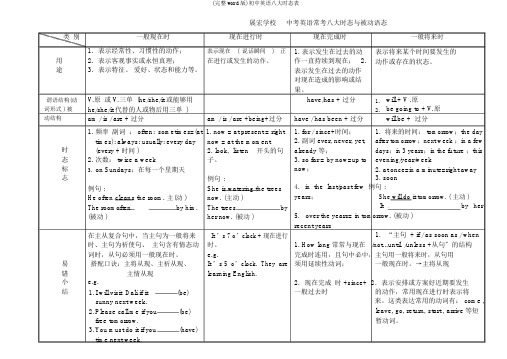
展宏学校中考英语常考八大时态与被动语态类别一般现在时现在进行时现在完成时一般将来时用途谓语结构(动词形式 ) 被动结构时态标志1.表示经常性、习惯性的动作;表示现在(说话瞬间)正2.表示客观事实或永恒真理;在进行或发生的动作。
3.表示特征、爱好、状态和能力等。
V.原或 V.三单 (he/she/it 或能够用he/she/it 代替的人或物后用三单 )am / is / are + 过分am / is / are +being+过分1. 频率副词: often;sometimes=(at 1. now = at present = righttimes); always; usually; every day now = at the moment(every + 时间 ) 2. look, listen开头的句2. 次数: twice a week子。
3. on Sundays:在每一个星期天例句 :例句 :She is watering the treesHe often cleans the room. 主(动 )now. (主动 )The roomoften by him.The trees by(被动 )her now. (被动 )1. 表示发生在过去的动表示将来某个时间要发生的作一直持续到现在; 2.动作或存在的状态。
表示发生在过去的动作对现在造成的影响或结果。
have/has + 过分 1.will + V .原2.be going to + V.原have / has been + 过分will be + 过分1. for / since+时间; 1.将来的时间: tomorrow;the day2. 副词 ever, never, yet,after tomorrow;next week ;in a fewalready 等;days;in 3 years;in the future ;this3. so far = by now=up to evening/year/weeknow; 2. at once=in a minute=right away3.soon4.in the last/past few 例句 :years;She will do it tomorrow. ( 主动 )It by her5.over the years= in tomorrow. (被动 )recent years在主从复合句中,当主句为一般将来It ’s 7 o’clock + 现在进行时、主句为祈使句、主句含有情态动时。
初中英语八大时态总表

主动
结构
was/were + V-ing
have/has + V.pp
should + V.原would + V.原
was/ were going to + V.原
had + V.pp
被动结构
was/were + being +V.pp
have/has been + V.pp
would be + V.pp
Am/is/are + being + V.pp
项目分类
过去进行时
现在完成时
过去将来时
过去完成时
定
义
表示过去某一时刻或
某一段时间正在进行的动作。
1.表示过去发生的动作对现在
造成的影响或结果。
2.表示过去发生的动作一直持续
到现在。
表示从过去某一时间看将要发生的动作或存在的状态。经完成的动作或状态。
初中英语时态总结
一般现在时
一般过去时
一般将来时
现在进行时
定
义
1.表示经常性、习惯性动作。
2.表示客观事实或永恒真理。
3.表示特征、爱好、状态和能力等。
表示在过去某一点或
某一段时间发生的动
作或存在的状态。
1.表示将来某个时间要发生的
动作或存在的状态.
2.表示将来经常或反复发生
的动作.
1.表示现在(说话瞬间)正在进行或发生的动作.
2.表示当前一段时间内的活动或现阶段正在进行的动作.
主动结构
V.原主语(单三)+ V.s/es
V.ed
1.will + V.原
(完整版)初中英语八种时态归纳一览表

last week(year, night, month…),
at the age of 5, one day, long long ago, once upon a time, etc.
was/were+ not + doing
把was或were放于句首
现在完成时:
过去发生或已经完成的动作对现在造成的影响或结果,或从过去已经开始,持续到现在的动作或状态。
recently,lately, since…for…,
in the past few years, etc.
have/has+ done
①am/is/are+not;
②此ห้องสมุดไป่ตู้态的谓语动词若为行为动词,则在其前加don't,如主语为第三人称单数,则用doesn't,同时还原行为动词。
①把be动词放于句首;②用助动词do提问,如主语为第三人称单数,则用does,同时,还原行为动词。
一般过去时
过去某个时间里发生的动作或状态;过去习惯性、经常性的动作、行为
2will/shall + do.
①was/were + not;②在行为动词前加didn't,同时还原行为动词。
①be放于句首;②will/shall提到句首。
过去将来时
立足于过去某一时刻,从过去看将来,常用于宾语从句中
the nextday(morning, year…),the following month(week…),etc
was/were/going to + do;
初中英语八种时态归纳总结表格版(完整资料).doc

过
过去习惯 night ,month…), 问:Was/Were + 主语 + 其 性、经常性 in1989, just now , 他?
特殊:Wh… +did 的疑问句?
去 的动作、行 at the age of 5, one 答:Yes …be ./ No ,…be not .
为。
day,
特殊:Wh… + was/ were 的疑问
进 一时刻正在 或 when 引导的一
行 发生或进行 般过去时的时间
时 的行为或动 状语
作
问:Was /Were 主语 +doing ? 答:Yes …was/ were ./ No ,…was /were not 特殊:Wh…+ Be 主语 + 疑问句?
过去发 recently,
基本结构:
注意:当与一段时间连用时,
时 果,
ago)
或从过去已 in the past few
过去分词) 问句:主语+have/ has + done(动词的过去
have died = have been
经开始,持 years,
分词)?
dead …………
续到现在的 动作或状
答:Yes …have /has ./ No ,…have/has not . have been to :
+ 其他
否定:主语 + don't / doesn’t + 动原
否定:主语+ am/is/are + not + 问句:Do /Does + 主语 + 动原?
现 在的某种状 month…),
初中英语语法八大时态总结表格
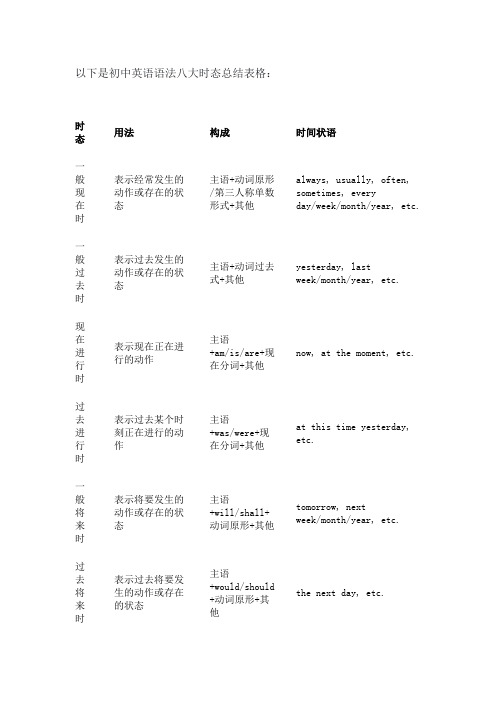
以下是初中英语语法八大时态总结表格:时态用法构成时间状语一般现在时表示经常发生的动作或存在的状态主语+动词原形/第三人称单数形式+其他always, usually, often,sometimes, everyday/week/month/year, etc.一般过去时表示过去发生的动作或存在的状态主语+动词过去式+其他yesterday, lastweek/month/year, etc.现在进行时表示现在正在进行的动作主语+am/is/are+现在分词+其他now, at the moment, etc.过去进行时表示过去某个时刻正在进行的动作主语+was/were+现在分词+其他at this time yesterday,etc.一般将来时表示将要发生的动作或存在的状态主语+will/shall+动词原形+其他tomorrow, nextweek/month/year, etc.过去将来时表示过去将要发生的动作或存在的状态主语+would/should+动词原形+其他the next day, etc.时态用法构成时间状语现在完成时表示过去发生的动作对现在造成的影响或结果主语+have/has+过去分词+其他already, yet, ever, never,for/since, etc.过去完成时表示过去某个时间之前已经完成的动作主语+had+过去分词+其他by the time, before, etc.需要注意的是,这些时态的构成和用法可能会有一些例外情况,具体取决于语境和句子结构。
此外,不同的教材和地区可能会有一些差异,因此在学习过程中,建议你参考多种资料,以便更好地理解和掌握这些时态。
- 1、下载文档前请自行甄别文档内容的完整性,平台不提供额外的编辑、内容补充、找答案等附加服务。
- 2、"仅部分预览"的文档,不可在线预览部分如存在完整性等问题,可反馈申请退款(可完整预览的文档不适用该条件!)。
- 3、如文档侵犯您的权益,请联系客服反馈,我们会尽快为您处理(人工客服工作时间:9:00-18:30)。
①was/were + not;②在行为动词前加didn't,同时还原行为动词。
①be放于句首;②will/shall提到句首。
过去将来时
立足于过去某一时刻,从过去看将来,常用于宾语从句中
the nextday(morning, year…),the following month(week…),etc
放于句首
一般将来时
表示将要发生的动作或存在的状态及打算、计划或准备做某事
tomorrow,next day(week, month, year…),soon, in a few minutes, by…,the day aftertomorrow, etc.
1am/is/are+
going to + do;
was/were+ not + doing
把was或were放于句首
现在完成时:
过去发生或已经完成的动作对现在造成的影响或结果,或从过去已经开始,持续到现在的动作或状态。
recently,lately, since…for…,
in the past few years, etc.
have/has+ done
A. He joined theLeague two years ago.
B. He has been inthe League for two years.
C. It is two yearssince he joined the League.
D. Two years haspassed since he joined the League.
①am/is/are+not;
②此时态的谓语动词若为行为动词,则在其前加don't,如主语为第三人称单数,则用doesn't,同时还原行为动词。
①把be动词放于句首;②用助动词do提问,如主语为第三人称单数,则用does,同时,还原行为动词。
一般过去时
过去某个时间里发生的动作或状态;过去习惯性、经常性的动作、行为
时态
概念
时间状语
基本结构:
否定结构
疑问结构
一般现在时
经常、反复发生的动作或行为及现在的某种状况。
always,usually,often, sometimes, every week (day, year, month…), once a week, on Sundays, etc.
①be动词;
②行为动词
was/were/going to + do;
②would/should + do.
①was/were/not + going to + do;
②would/should + not + do.
①was或were放于句首;
②would/should提到句首。
在现在完成时中,延续性动词能与表示一段时间的状语连用,瞬间动词却不能。但是,可用別的表达方式:①瞬间动词用于“一段时间+ ago”的一般过去时的句型中;②瞬间动词可改成与之相对应的延续性动词及短语,与一段时间连用;③瞬间动词用于“It is +一段时间+ since +一般过去时”的句型中,表示“自从……以来有……时间”的意思,主句一般用it is来代替It has been;④瞬间动词用于“Some time haspassed since +一般过去时”的句型中。请看:
have/has+ not +done.
have或has放于句首
过去完成时
以过去某个时间为标准,在此以前发生的动作或行为,或在过去某动作之前完成的行为,即“过去的过去”。
before,
by the end of last year(term, month…),etc.
had +done
had + not+ done
①be动词;
②行为动词
否定形式:①was/were+not;
②在行为动词前加didn't,同时还原行为动词。
①was或were放于句首;
②用助动词do的过去式did提问,同时还原行为动词。
现在进行时
表示现阶段或说话时正在进行的动作及行为
now, atthis time, these days, etc
基本结构:am/is/are+doing
am/is/are+not+doing.
把be动词放于句首
过去进行时
表示过去某段时间或某一时刻正在发生或进行的行为或动作
at thistime yesterday, at that time或以when引导的谓语动词是一般过去时的时间状语等。
was/were+doing
ago,yesterday, the day before yesterday,in 1989,just now,
last week(year, night, month…),
at the age of 5, one day, long long ago, once upon a time, etc.
